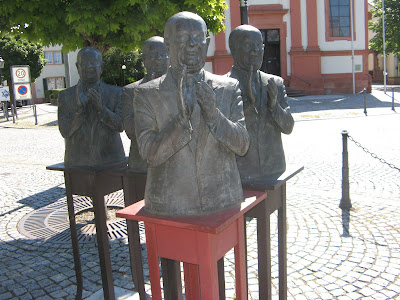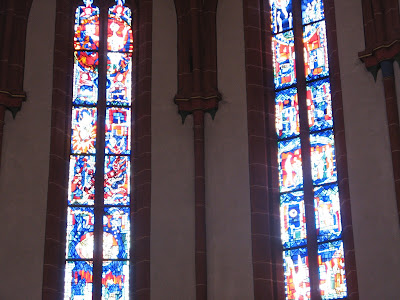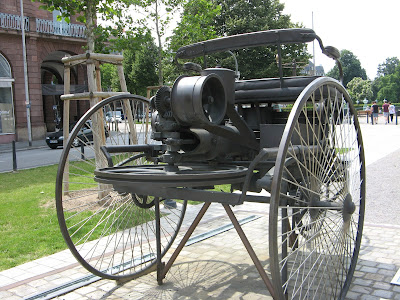Not sure what these sculptures represent but they were different!
Just before going in we admired this sculpture of a Spargelfrau - a woman selling white asparagus which is considered to be the gold of this area.
Schwetzingen Palace was the summer residence for Palatinate Electors of the 18th century. The central part of the gardens, including the wings of the main building which forms a semi-circle, leafy avenues and circular parterre is laid out geometrically with a focus on symmetry and order. There are a great number of sculptures throughout the grounds.
This is one of the semi-circular wings but the photo does not do it justice.
We headed down this tree-lined path for quite a distance and almost turned back becuse we thought we were getting too far from the main part of the Palace. Then we caught sight of what looked like an interesting construction.
We consulted the map to discover that it was in fact a mosque , the largest structure of its kind in a German garden. It was designed by Nicolas de Pigage. I wondered if we could go in and discovered that it serves no religious purpose but is purely decorative. It is beautiful!
When we got round to the front of the mosque it was in a beautiful lake-side setting and the water was so still it reflected the building and the trees. The Turkish garden is also very beautiful.
Farther on were the ruins of another temple.
We walked for about 2 hours and even then we have not seen half of what there is to see!
Mother duck carefully watching her flock as they pecked around her, lazed in the sun or hada refreshing swim.
The facade is under repair
And after all the walking kaffee und kuchen (apfel)
Our next port of call was Ladenburg described by Werner and Kirsten as a pretty little Roman town. And it is very pretty! There was some kind of festival on we think asall the restaurants had extra tables set outside sith white or cream tablecloths and bench covers.
 |
| Jim got my goat! |
These two sculptures/fountain were part of one and seemed to refer to some rift between Church and State.
The Protestant Church was open so we took a look. There had obviously been a wedding there recently as the flowers on the sides of the pews and beside the altar were very fresh.
Ladenburg is full of history and has a lot of Roman ruins. For some reason Jim didn't take any photos of them. As in lots of other places, some streets were being repaired so we had lots of stops to remove gravel from feet and sandals.
Next stop was Mannheim and on entering the city, we could see why Jorgen was reluctant to send us there. Mannheim is the third largest city in Baden Wuerttemberg. It is located at the confluence of the Neckar and the Rhine. It is unusual among German cities in that its streets and avenues are laid out in a grid fashion leading to its nickname @die Quadratestadt (city of the squares). Thereare lots of high-rise buildings which did not appeal to me. We made our way to Friedrichsplatz and found it to be a beautiful art nouveau area. It is composed of a Romanesque water tower made of yellow sandstone with an open staircase , down the centre of which cascades water running to the fountain below. It is a very popular place for strolling and relaxing.
There's a lot more to Mannheim than we took time to see. Our feet were aching from the combination of heat and walking. It had been a long day but a very enjoyable one visually.











































































No comments:
Post a Comment